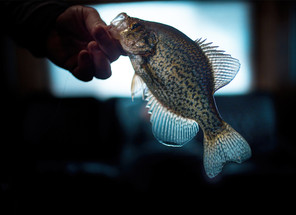Posted by Will Allen on 12th Jun 2025
Ice Fishing for Crappies with Plastics
Ice fishing for crappies is a thrilling winter pursuit, and using plastics as lures has revolutionized the sport. Crappies, known for their tasty fillets and feisty fights, are a favorite target for ice anglers across North America. Soft plastic baits, with their lifelike action and versatility, have become a go-to choice for enticing these panfish through the ice. This guide explores the best techniques, gear, and strategies for ice fishing crappies with plastics, ensuring a successful and enjoyable experience on the hardwater.
Advantages of Plastics for Ice Fishing Crappies
Soft plastics offer several advantages over traditional live bait, like minnows or waxworms. They’re durable, cost-effective, and eliminate the hassle of keeping bait alive in extreme conditions. They also tend to stay on the hook longer than traditional bait. Less time baiting your hook means more time in the strike zone for your lures.
Plastics come in a variety of shapes, sizes, and colors, allowing anglers to mimic crappie’s natural prey, such as small minnows, insects, or zooplankton. Their subtle, lifelike movements in the water column are particularly effective for finicky crappies, which often require finesse to trigger a bite. Plus, plastics can be scented or infused with attractants, adding an extra edge in cold water where fish metabolism slows.
Choosing the Right Plastics
The key to success lies in selecting the right soft plastics. Small, 1- to 2-inch tube jigs, paddle tails, and curly tail grubs are top choices for crappies. Brands like Northland Tackle, Z-Man, and VMC offer specialized ice fishing plastics designed for panfish. Tubes provide a hollow body that mimics small baitfish, while paddle tails create a subtle vibration that crappies can’t resist. Curly tails add extra wiggle, ideal for slow presentations. Popular colors include natural hues like white, chartreuse, pink, and glow-in-the-dark options for low-light conditions under the ice. Experimenting with colors is crucial, as crappie preferences can vary daily based on water clarity and light penetration.
Gear Setup for Plastics
A light, sensitive rod and reel combo is essential for detecting crappie bites, which can be subtle in winter. A 24- to 30-inch ultralight rod with a fast tip pairs well with a 500-series spinning reel spooled with 2- to 4-pound test monofilament or fluorocarbon line. Fluorocarbon is preferred for its low visibility and abrasion resistance around ice edges. Pair the line with a small tungsten jighead, typically 1/64 to 1/32 ounce, to match the plastic’s size and weight. Tungsten jigs sink faster and offer better sensitivity, allowing anglers to feel light bites in deeper water.
Read: Best Ice Fishing Rods For Ice Fishing Crappies
Finding Crappies Under the Ice
Crappies often suspend in the water column during winter, seeking warmer water and food sources like zooplankton. Early in the season, target shallow weed beds or flats in 6 to 15 feet of water, where crappies feed on insects and small baitfish. As winter progresses, they move to deeper basins or structure like drop-offs, humps, or submerged timber, often suspending in 20 to 40 feet. Live sonar has become the norm when it comes to locating fish, but anglers are still finding and catching fish with traditional flashers. Underwater cameras can also be invaluable for locating schools and pinpointing their depth. Drill multiple holes to cover a range of depths and structures, and move frequently if fish aren’t active.
Techniques for Fishing Plastics
Finesse is the name of the game when ice fishing crappies with plastics. Start by dropping your jig and plastic to the depth where fish are marked on your sonar, often just above or within the school. Use a slow, subtle jigging motion—small twitches, lifts, or quivers—to impart lifelike action to the plastic. A common technique is the “pound and pause,” where you gently tap the rod to make the plastic dance, then let it sit still for 5 to 10 seconds. Crappies often strike during the pause, so watch your spring bobber or line for subtle movements. If fish are aggressive, try a slightly faster retrieve or a swimming motion to mimic fleeing baitfish. Vary your cadence until you find what triggers bites.
Tips for Success
- **Match the Hatch**: Observe local forage through clear ice or research typical crappie prey in your lake. Choose plastics that mimic size and color of natural food.
- **Glow Plastics**: In murky water or during dawn/dusk, glow-in-the-dark plastics can increase visibility. Charge them with a flashlight before dropping.
- **Scent Enhancement**: Apply fish attractant gels to plastics to entice sluggish crappies, especially in cold fronts.
- **Stay Mobile**: Crappies school tightly in winter. If you’re not getting bites after 10 minutes, move to a new hole.
- **Check Regulations**: Ensure you’re following local ice fishing rules, including bag limits and licensing requirements.
Best Times and Conditions
Prime times for crappie ice fishing are early morning and late afternoon, when fish are most active. Overcast days or light snow can improve bites by reducing light penetration through the ice. Stable weather patterns often lead to better fishing than drastic pressure changes. Early and late ice seasons are typically most productive, as crappies are more aggressive before settling into midwinter patterns.
Why Crappie Fishing with Plastics Shines
Ice fishing for crappies with plastics combines strategy, finesse, and the thrill of the catch. The versatility of plastics allows anglers to adapt to changing conditions, and their durability makes them a practical choice for cold weather fishing trips. Whether you’re a seasoned ice angler or a beginner, mastering plastics opens up a world of winter fishing opportunities. Bundle up, drill some holes, and enjoy the challenge of hooking crappies through the ice with these dynamic lures. Happy fishing!

